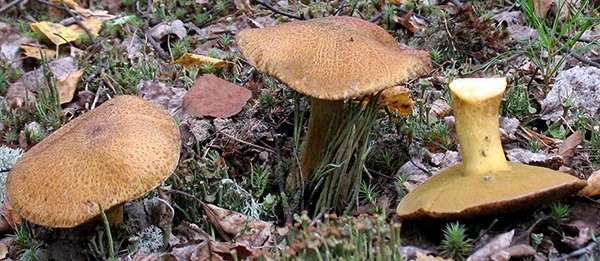Yellow-brown butterdish (Suillus variegatus)
- Diviziona: Basidiomycota (Basidiomycetes)
- Fizarana: Agaricomycotina (Agaricomycetes)
- Kilasy: Agaricomycetes (Agaricomycetes)
- Kilasy: Agaricomycetidae (Agaricomycetes)
- Karazana: Boletales (Boletales)
- Fianakaviana: Suillaceae
- Karazana: Suillus (Oiler)
- Type: Suillus variegatus (Yellow-brown butterdish)
- Butterdish motley
- Bog moss
- Mokhovik sandy
- Flywheel yellow-brown
- honahona
- mara
- Boletus variegatus
- Ixocomus variegatus
- Squid mushroom

Hat: At the yellow-brown oiler, the hat is first semicircular with a tucked edge, later cushion-shaped, 50-140 mm in diameter. The surface is initially olive or gray-orange, pubescent, which gradually cracks into small scales that disappear in maturity. In young mushrooms, it is gray-yellow, gray-orange, later brown-reddish, light ocher in maturity, sometimes slightly mucous. The peel is very poorly separated from the pulp of the cap. Tubules 8-12 mm tall, initially adhering to the stem, later slightly cut, initially yellow or light orange, dark olive at maturity, slightly blue on the cut. The pores are initially small, then larger, gray-yellow, then light orange and finally brown-olive, slightly blue when pressed.
Leg: The leg of the butter dish is yellow-brown, cylindrical or club-shaped, made, 30-90 mm high and 20-35 mm thick, smooth, lemon-yellow or a lighter shade, in the lower part it is orange-brown or reddish.
Flesh: Firm, light yellow, light orange, lemon-yellow above the tubules and under the surface of the stem, brownish at the base of the stem, slightly bluish in places on the cut. Without much taste; with a scent of pine needles.
Spore Powder: Olive brown.
Spores: 8-11 x 3-4 µm, ellipsoid-fusiform. smooth, light yellow.

Growth: Yellow-brown butterdish grows primarily on sandy soil from June to November in coniferous and mixed forests, often in very large quantities. Fruiting bodies appear singly or in small groups.
Range: Yellow-brown butterdish is known in Europe; in Our Country – in the European part, in Siberia and the Caucasus, reaching north to the limit of pine forests, as well as in the mountain forests of Siberia and the Caucasus.
Use: Edible (3rd category). A little-known edible mushroom, but not very tasty. Young fruiting bodies are best marinated.
Similarity: The yellow-brown butter dish looks like a flywheel, for which it is often called kodiaran-tselatra mavo-volontsôkôlà.









